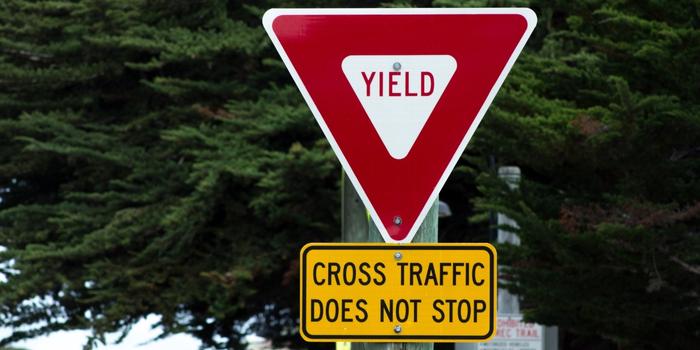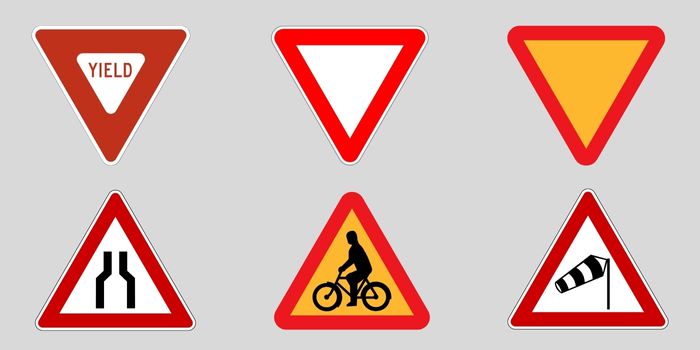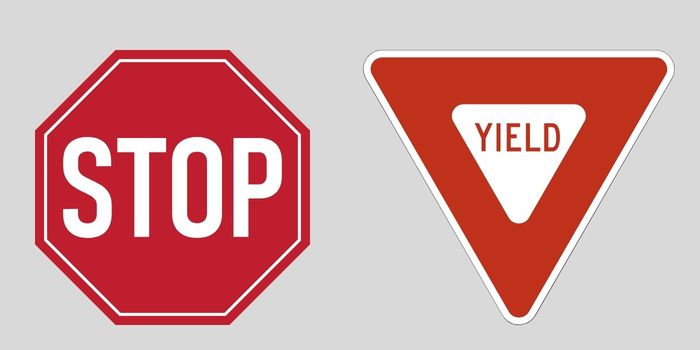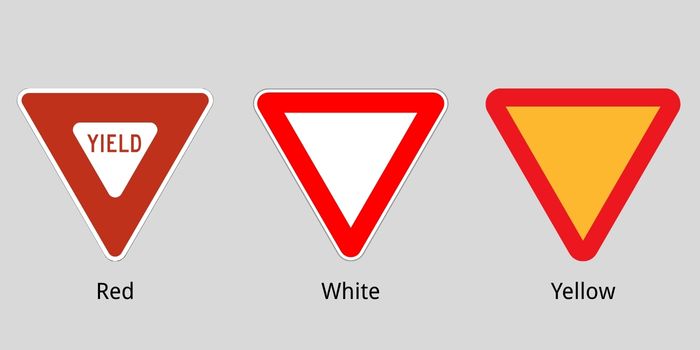When we talk about road safety signs, yield signs are one of them that are simple but have an important role to maintain traffic flow. When you drive, you may see these signs at intersections & pedestrians crossing. But do you really know what yield sign means?
That’s why we have prepared this article for you. We will explain the meaning of yield sign, its types, sizes, colors & official yield sign requirements by MUTCD.
What Does a Yield Sign Mean
Yield signs are a type of road safety sign that help you to know when you should slow down your vehicle and where you should stop. It has a red border and a white center. You will see the word “YIELD” written in red letters in the middle of signs.
Plus, you will find these signs mostly at the median area, pedestrian crossing, merging lanes and roundabouts. In some places, the sign says “Give Way” instead of “Yield”, but both have the same meaning.

What To Do At A Yield Sign?
Whenever you see yield signs around you, the first thing you should do is reduce your car speed. You also have to be prepared for a complete stop if it is required (according to situations). For example: If you notice another car/person is already present on the road, you should wait and let them go first. This is called “yielding.” According to road safety authorities standard and traffic law:
- You should look to your left and right sides to check for cars, bikes and people.
- If you observe that the road is clear you can go.
- If someone is already there, you need to let them go first.
- When there is heavy traffic on the road, you should completely stop your car.
Types of Yield Signs
Below are some common types of yield signs.

Yield To Pedestrians Sign
You will see these yield signs around crosswalks, schools and busy sidewalks. They are installed to remind you that you need to slow down your car and let pedestrians cross the road. You have to stop (even if you are in a hurry) if someone is already present on the road. Moreover, you can identify this sign as the word “YIELD”, an arrow which points to where people walk & tells you to stop for foot traffic.
Yield Right of Way Meaning
When you notice a sign that says to you “Yield Right of Way,” that means you should let others go first. Well, you don’t always need to stop, but you have to reduce your vehicle speed & check the highway.
If you observe another car, bike or person is near you, you should wait and allow them to pass. This helps you prevent accidents and keeps traffic movement smooth.
Yield to Bicycles
Yield to bicycles signs are placed to tell you that around this sign’s presence, you should give space to cyclists on the road. You will generally see these signs near bike lanes, crossings and shared paths. If you ignore this sign, you may put a rider in danger and you can also cause a crash. Always remember to check for bikes and cycles before you move your vehicle forward.
Roundabout Yield Sign
Roundabout yield signs are placed to tell you that you need to allow traffic in the roundabout to pass before you enter. If you don’t wait and move your vehicle into the roundabout, it can be dangerous for you & may lead to crashes.
Hence, you should always look to your left and only go when you think there is a safe gap. If you ignore this safety standard, you may cause traffic collisions and danger for everyone around you.
Yield To Oncoming Traffic
You will see this sign at sharp turns, no lane bridges and construction zones. Generally, these signs are installed where the road is too narrow for two vehicles when you need to pass them at the same time. So, if you spot “Yield to Oncoming Traffic” signs, you have to provide space for other vehicles which are on the way from other directions.
Temporary Yield Signs
Temporary yield signs are installed to guide you in areas where normal traffic rules have changed for a short time. You will usually see them in places such as construction zones, road repairs and during special events. Further, these signs tell you to follow the flow of traffic, stay alert & be ready to stop if needed.
Right Turn Yield Sign
Right turn yield sign is placed at intersections where you have to turn right. Whenever you observe the right turn sign, you should slow your car and yield to oncoming traffic, cyclists & pedestrians as well.
It also reminds you that you have to wait to change your vehicle directions until you find enough gap for your car to turn. These types of yield signs are very important when you need to merge your automobile into a busy lane.
Do You Have To Stop At a Yield Sign (Yield vs Stop Sign)
A stop sign means you always have to stop, even if there is no one around you on the highway.
On the other hand, a yield sign means you should minimize your car speed. Always remember, you can’t go until other vehicles have passed if they are already on the road.
| Features | Yield Sign | Stop Sign |
| What to Do | You need to slow down (stop if required). | Always need to stop completely. |
| When to Stop | Only if you see other cars/people coming. | Stop every time you observe the stop signs. |
| Shape | Triangle (upside down) | Octagon (8 sides) |
| Color | Red border with white center and red text inside. | Only red with white letters. |
| Installation | Placed at less busy roads & merging lanes. | Use at very busy highways and intersections. |

Is Failure To Yield a Moving Violation?
Definitely yes, failure to yield is a moving violation because it happens when your vehicle is in motion and you do not give the right of way when required. This includes situations such as not yielding at a yield sign and if you ignore pedestrians in crosswalk.
Moreover, there will also be moving violations at yield, if you turn your car to the left side without waiting for oncoming traffic and not provide space for emergency vehicles to pass. This is a serious illegal action that can cause accidents and you may face fines & points on your license.
Shape of Yield Sign
The yield sign has a unique triangular shape which is pointing downward. This shape was preferred by AASHO (American Association of State Highway Officials). Because, this design is easy for you to recognize and not used for any other traffic sign. Additionally, you can identify the yield instruction from a distance and you can also see it when visibility is low.
Yield signs were accepted as official road signs when traffic rules included it in 1954 by MUTCD. At that time, it had a triangle shape and red border without any text. Later, it changed to a red/white inverted triangle and the word “YIELD” in bold red letters.
Where are Yield Signs Usually Placed
Yield signs are generally installed at locations where vehicles need to slow down and provide the right of way to other people. For example: you will see them on road merges, roundabouts, intersections with less traffic, highway on-ramps and exits. These signs tell you that you need to be alert and also allow others to pass safely before you move forward.
What Type of Sign is a Yield Sign?
Is a Yield Sign a Regulatory Sign
Yes, a yield sign is definitely a regulatory sign. That means, it gives you a rule which you have to follow at all times. It’s not just a suggestion for you. Whenever you see this sign, you need to slow down your car and always allow others to move if needed. So we can say that, it’s not just a general traffic rule, it’s a strict law related traffic safety standard that you have to obey in all situations.
Is Yield Sign a Warning Sign
Warning signs only inform you that something is ahead such as: a sharp turn and crossing. On the other hand, the yield sign tells you what to do. So, the answer is: yield signs are absolutely not warning signs. Because, these signs provide you with clear rules about when you should stop completely.
Yield Sign Dimensions or Yield Sign Size
If we talk about yield sign size, they have standard shape and size. So that you can easily see them when you drive. Generally, you will notice red and white triangle shaped yield signs.
According to their placement location, you have to follow unique dimensions standard for different kinds of yield size. For example: a 36-inch yield sign is the normal size that you will see on most roads everyday. Because, it works well for your city streets & small roads.
But for busy roads such as highways/expressways where cars move faster, you need to install a 48 inches yield sign. This size is enough for you to see on that type of heavy traffic road. However, you can also use a 24 inch sign for a quiet location and 18 inch sign board for special zones such as near crosswalks.
Additionally, the yield sign size also varies according to how fast your cars go on road, how many lanes there are and how easy it is to see the road crossing as well.
What Color is a Yield Sign
You can see the sign better from a far distance, if its color has high visibility. That’s why yield signs have two present standard colors which make them highly noticeable for you.

Red Yield Sign
The red color is used for yield markers because it is a sign of danger and you can quickly spot them from a distance. You will see a red border with a white center and bold red letters that say you “YIELD”.
These types of signs have a triangle shape which points downward to warn you about possible hazards on the road. In addition, these colored yield signs are regulatory signs and you will see them at merging lanes, roundabouts and intersections.
White Yield Sign
Well, you will not find white yield signs on public roads today, but you may see them in private areas such as parking lots, factory roads & industrial zones. They have a plain white background with black or red text. White yield signs have inverted triangle shapes and are not part of the official traffic sign system for highways.
Yellow Yield Sign
Before red and white color yield signs, there is yellow color used for signs. This color was a past standard of yield signs which warn drivers and direct them what they should do. But over time, traffic experts decided to change the color from yellow to red and white. The reason was to match the color with other traffic signs and make them more highlighted. So that highways look more consistent to you and also simple for you to follow.
MUTCD Yield Sign Rules
According to the MUTCD (Manual on Uniform Traffic Control Devices), the official yield sign has following standards:
- The sign must have a red triangle (downward-pointing) with a white center and red “YIELD” text. This is the only design you can use on public roads.
- You can’t place old yellow signs and white yield signs on public roads anymore. If you see a white yield sign, it may be on private property and private driveway.
- MUTCD also says that yield signs should be clearly visible to you, properly sized and placed where drivers have enough time to react.
- You need to install a yield sign in such a way that it should be at least 5 feet above the ground (7 feet for urban areas).
- Plus, you can place standard size signs (36 inches wide) for regular roads, but for high speed roads you have to use large size signs.
- Always remember, you should use an illuminated yield sign. So that they can be visible to you at night.
- You must also check that nothing can block the view of your yield marking such as trees, poles or other signs.
Summing Up
In the end, we hope now you have all the information about yield signs, their types, meaning and where you can place/find them. As a responsible driver, it’s important for you to follow these road safety signs regulations, so that you can avoid accidents and traffic violations.
Do you want high-quality yield signs in bulk quantity? JACKWIN is your trusted supplier in China. Tell us today about your requirements and get a quick quote for customized road products.
More Related Topics:


-80x69.png)

